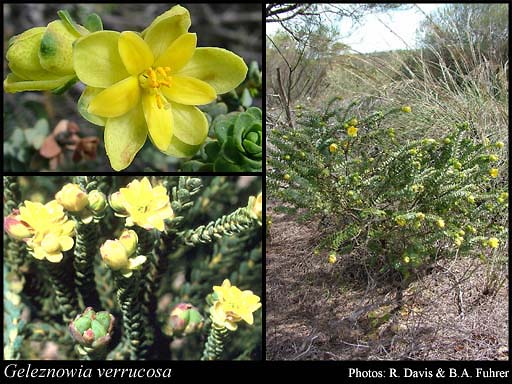- Reference
- Bull.Soc.Imp.Naturalistes Moscou 22(3):13, Tab. 1 (1849)
- Conservation Code
- Not threatened
- Naturalised Status
- Native to Western Australia
- Name Status
- Current
Shrub, 0.1-1(-1.5) m high. Fl. yellow, Jul to Oct. Sandy & gravelly soils. Sandplains.

Scientific Description
Shrub, spines absent; branchlets verrucose (warty), +/- cylindrical in cross-section, covered in hairs or scales, the hairs stellate (star-shaped). Leaves alternate, simple, 3-6 mm long, 2-2.5 mm wide, flat, the margins flat, verrucose (warty), covered in hairs or scales, with stellate (star shaped) hairs; stipular excrescences absent. Flowers in a distinct head surrounded by bracts, the outer bracts 5-8 mm long; pedicels 1-5.5 mm long; calyx present, 6-12 mm long, verrucose (warty), glabrous except for a ciliate marginal fringe, the hairs stellate (star-shaped); corolla yellow, petals five, 6-8 mm long, imbricate (overlapping), free, glabrous; stamens twice as many as petals, 2.5-3 mm long, smooth, glabrous; anthers 1 mm long, without an appendage. Flowers in July, August, September and October. Occurs in the Eremaean and South-West Botanical Province, in the Yalgoo, Avon Wheatbelt, Swan Coastal Plain and Geraldton IBRA region(s).
Distribution
- IBRA Regions
- Avon Wheatbelt, Carnarvon, Geraldton Sandplains, Swan Coastal Plain, Yalgoo.
- IBRA Subregions
- Dandaragan Plateau, Edel, Geraldton Hills, Lesueur Sandplain, Merredin, Wooramel.
- Local Government Areas (LGAs)
- Carnamah, Chapman Valley, Coorow, Dandaragan, Dowerin, Greater Geraldton, Irwin, Moora, Morawa, Northampton, Shark Bay, Three Springs.